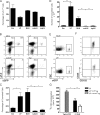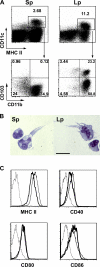Small intestine lamina propria dendritic cells promote de novo generation of Foxp3 T reg cells via retinoic acid
- PMID: 17620362
- PMCID: PMC2118682
- DOI: 10.1084/jem.20070602
Small intestine lamina propria dendritic cells promote de novo generation of Foxp3 T reg cells via retinoic acid
Abstract
To maintain immune homeostasis, the intestinal immune system has evolved redundant regulatory strategies. In this regard, the gut is home to a large number of regulatory T (T reg) cells, including the Foxp3(+) T reg cell. Therefore, we hypothesized that the gut environment preferentially supports extrathymic T reg cell development. We show that peripheral conversion of CD4(+) T cells to T reg cells occurs primarily in gut-associated lymphoid tissue (GALT) after oral exposure to antigen and in a lymphopenic environment. Dendritic cells (DCs) purified from the lamina propria (Lp; LpDCs) of the small intestine were found to promote a high level of T reg cell conversion relative to lymphoid organ-derived DCs. This enhanced conversion by LpDCs was dependent on TGF-beta and retinoic acid (RA), which is a vitamin A metabolite highly expressed in GALT. Together, these data demonstrate that the intestinal immune system has evolved a self-contained strategy to promote T reg cell neoconversion.
Figures






Comment in
-
Oral tolerance: is it all retinoic acid?J Exp Med. 2007 Aug 6;204(8):1737-9. doi: 10.1084/jem.20071251. Epub 2007 Jul 9. J Exp Med. 2007. PMID: 17620364 Free PMC article.
Similar articles
-
A functionally specialized population of mucosal CD103+ DCs induces Foxp3+ regulatory T cells via a TGF-beta and retinoic acid-dependent mechanism.J Exp Med. 2007 Aug 6;204(8):1757-64. doi: 10.1084/jem.20070590. Epub 2007 Jul 9. J Exp Med. 2007. PMID: 17620361 Free PMC article.
-
A new subset of CD103+CD8alpha+ dendritic cells in the small intestine expresses TLR3, TLR7, and TLR9 and induces Th1 response and CTL activity.J Immunol. 2011 Jun 1;186(11):6287-95. doi: 10.4049/jimmunol.1004036. Epub 2011 Apr 27. J Immunol. 2011. PMID: 21525388
-
All-trans retinoic acid mediates enhanced T reg cell growth, differentiation, and gut homing in the face of high levels of co-stimulation.J Exp Med. 2007 Aug 6;204(8):1765-74. doi: 10.1084/jem.20070719. Epub 2007 Jul 9. J Exp Med. 2007. PMID: 17620363 Free PMC article.
-
Modulation of T cell and innate immune responses by retinoic Acid.J Immunol. 2014 Apr 1;192(7):2953-8. doi: 10.4049/jimmunol.1303245. J Immunol. 2014. PMID: 24659788 Review.
-
FOXP3 and its role in the immune system.Adv Exp Med Biol. 2009;665:17-29. doi: 10.1007/978-1-4419-1599-3_2. Adv Exp Med Biol. 2009. PMID: 20429413 Review.
Cited by
-
Inflammation switches the differentiation program of Ly6Chi monocytes from antiinflammatory macrophages to inflammatory dendritic cells in the colon.J Exp Med. 2012 Jan 16;209(1):139-55. doi: 10.1084/jem.20101387. Epub 2012 Jan 9. J Exp Med. 2012. PMID: 22231304 Free PMC article.
-
Apoptotic cell-linked immunoregulation: implications for promoting immune tolerance in transplantation.Cell Biosci. 2015 Jun 7;5:27. doi: 10.1186/s13578-015-0019-9. eCollection 2015. Cell Biosci. 2015. PMID: 26110047 Free PMC article.
-
Vitamin D immunoregulation through dendritic cells.Immunology. 2016 Jul;148(3):227-36. doi: 10.1111/imm.12610. Immunology. 2016. PMID: 27040466 Free PMC article. Review.
-
Tumor Progression Locus 2 (Tpl2) Activates the Mammalian Target of Rapamycin (mTOR) Pathway, Inhibits Forkhead Box P3 (FoxP3) Expression, and Limits Regulatory T Cell (Treg) Immunosuppressive Functions.J Biol Chem. 2016 Aug 5;291(32):16802-15. doi: 10.1074/jbc.M116.718783. Epub 2016 Jun 3. J Biol Chem. 2016. PMID: 27261457 Free PMC article.
-
Peripheral and central regulation of neuro-immune crosstalk.Inflamm Regen. 2024 Sep 26;44(1):41. doi: 10.1186/s41232-024-00352-3. Inflamm Regen. 2024. PMID: 39327628 Free PMC article. Review.
References
-
- Jordan, M.S., A. Boesteanu, A.J. Reed, A.L. Petrone, A.E. Holenbeck, M.A. Lerman, A. Naji, and A.J. Caton. 2001. Thymic selection of CD4+CD25+ regulatory T cells induced by an agonist self-peptide. Nat. Immunol. 2:301–306. - PubMed
-
- Bettelli, E., Y. Carrier, W. Gao, T. Korn, T.B. Strom, M. Oukka, H.L. Weiner, and V.K. Kuchroo. 2006. Reciprocal developmental pathways for the generation of pathogenic effector TH17 and regulatory T cells. Nature. 441:235–238. - PubMed
Publication types
MeSH terms
Substances
Grants and funding
LinkOut - more resources
Full Text Sources
Other Literature Sources
Research Materials

